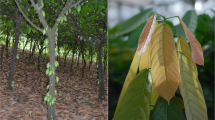Abstract
Populations of four perennial herbaceous species that were genetically modified for altered lignin content (or associated forage digestibility) by conventional plant breeding were evaluated for two agricultural fitness traits, plant survival and plant biomass, in three Northcentral USA environments for more than 4 years. Reduced lignin concentration or increased digestibility resulted in increased winter mortality in two of four species and reduced biomass in one species. Results from other experiment indicate that these apparent genetic correlations may be ephemeral, suggesting that selection for fitness can be successful within high-digestibility or low-lignin germplasm. Results indicate that perennial plants genetically engineered with altered lignin concentration or composition for use in livestock, pulp and paper, or bioenergy production should be evaluated for fitness in field environments prior to use in agriculture.
Similar content being viewed by others
Author information
Authors and Affiliations
Additional information
Received: 12 December 2000 / Accepted: 27 February 2001
Rights and permissions
About this article
Cite this article
Casler, M., Buxton, D. & Vogel, K. Genetic modification of lignin concentration affects fitness of perennial herbaceous plants. Theor Appl Genet 104, 127–131 (2002). https://doi.org/10.1007/s001220200015
Issue Date:
DOI: https://doi.org/10.1007/s001220200015




